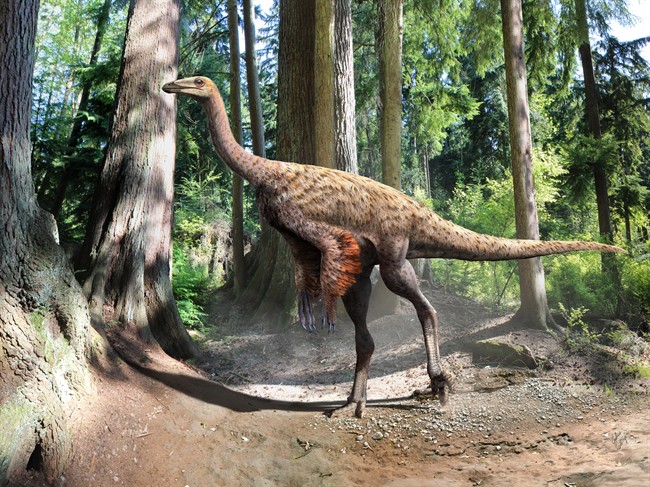EDMONTON – A University of Alberta dinosaur researcher was just looking for a project when he chose one fossil specimen out of others still lying around unexamined from a six-year-old dig.

But when Aaron van der Reest cracked the plaster shell protecting the 75-million-year-old specimen from southern Alberta, he got a lot more than that.
“My first thought was, ‘Is this actually what I think it is?'”
Van der Reest was studying ornithomimus, a dinosaur that looked very much like an ostrich. What he found on bones connecting the leg to the breast was something never seen before on a North American fossil — feathers.
“They look like little tiny black lines,” said the undergraduate in paleontology, who describes his findings in a journal paper published Wednesday. “The thickest is about a half-millimetre across.”
Feathered dinos have been found before, but most come from China. Not only is van der Reest’s sample believed to be a North American first, it’s one of the best-preserved in the world and includes a patch of skin.
“We can see individual feathers,” he said Wednesday, still sounding slightly in awe despite the two years it took him to clean and prepare the specimen.
The fossil reveals what ornithomimus’s tail plumage was like. Scientists are still studying molecules within the feathers to see if they hint at colour, but van der Reest can say they would have been fluffy, without the tiny hooks that hold the branches of modern feathers together.
- Canadian man dies during Texas Ironman event. His widow wants answers as to why
- On the ‘frontline’: Toronto-area residents hiring security firms to fight auto theft
- Honda’s $15B Ontario EV plant marks ‘historic day,’ Trudeau says
- Canadians more likely to eat food past best-before date. What are the risks?
READ MORE: New species of dinosaur called ‘Hellboy’ discovered in Alberta
As for the skin, it seems to have been mostly smooth with pores for feathers. It may have looked much like a plucked goose, he said.
The dinosaur would have looked so much like an ostrich, van der Reest theorizes ornithomimus used a combination of feathers and bare skin for the same reason today’s birds do — to regulate heat.
“It’s virtually identical,” he said. “Chances are ornithomimus is doing exactly the same thing (as ostriches).”
The correspondences are so strong van der Reest believes that they don’t just apply to his object of study.
“There’s a really good chance that other dinosaurs are doing the same thing,” he said.
Van der Reest is now a third-year bachelor’s student — pretty junior to have made such a significant find.
But he’s no beginner. Now 34, he’s been working on dinosaur fossils, preparing them for study and exhibition, since he was 16. He undertook the ornithomimus project in addition to his regular class load.
He knows making such a significant find as a first-year student is something special.
“I was pretty lucky. I don’t know if I’ve stopped smiling since.”

Comments